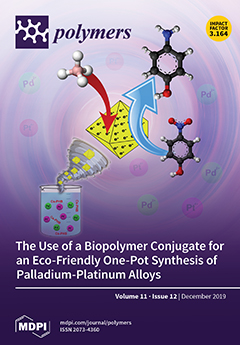A complexed initiating system AlCl
3·phenetole/TiCl
4·H
2O was prepared by simply compounding AlCl
3/phenetole and TiCl
4/H
2O and used for cationic polymerization of isobutylene. It was found AlCl
3·phenetole/TiCl
4·H
2O exhibited
[...] Read more.
A complexed initiating system AlCl
3·phenetole/TiCl
4·H
2O was prepared by simply compounding AlCl
3/phenetole and TiCl
4/H
2O and used for cationic polymerization of isobutylene. It was found AlCl
3·phenetole/TiCl
4·H
2O exhibited activities 1.2–3 times higher than those of AlCl
3/phenetole, and more than an order of magnitude higher than those of TiCl
4/H
2O, which indicated a notable synergistic effect produced in the complexed system. In addition, due to the higher activity of AlCl
3·phenetole/TiCl
4·H
2O, lower coinitiator concentration and polymerization temperature, as well as higher monomer concentration were more favored for this complexed initiating system to produce polyisobutylene (PIB) with reasonable molecular weight (M
w) and molecular weight distribution (MWD). Furthermore, high molecular weight polyisobutylene (HPIB) with M
w = 1–3 × 10
5 g·mol
−1 could be successfully produced by the complexed catalyst system at T
p = −60 to −40 °C. As a whole, the high activity as well as the simple preparation procedures of the complexed initiating system offer us a unique approach for the production of HPIB with improved efficiency.
Full article


